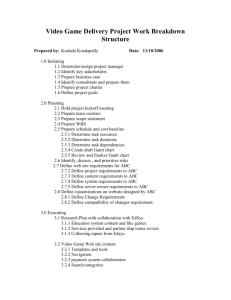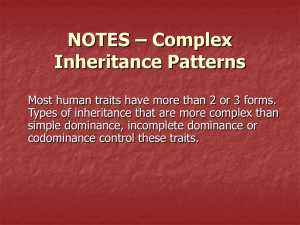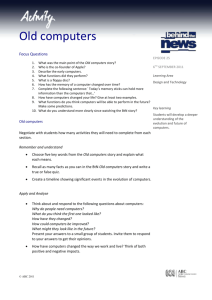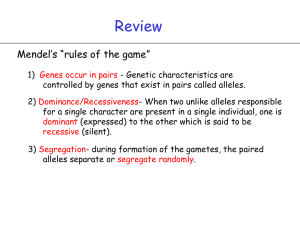Slide 1
advertisement
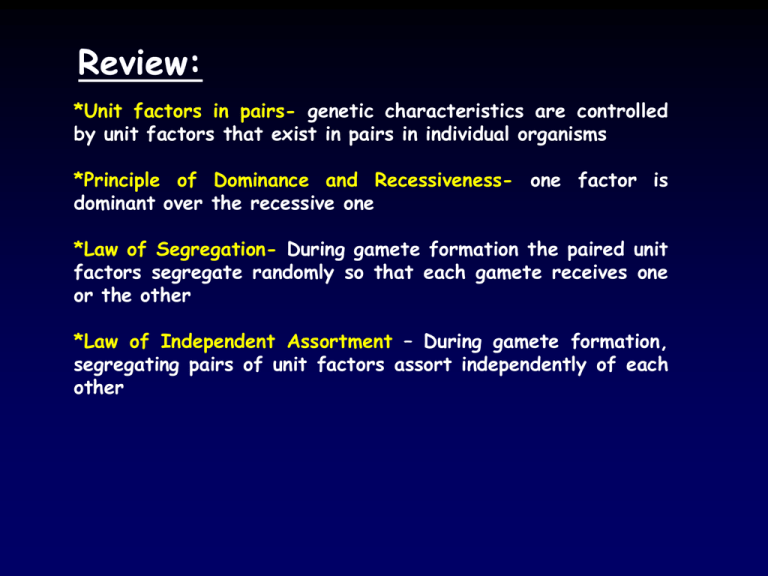
Review: *Unit factors in pairs- genetic characteristics are controlled by unit factors that exist in pairs in individual organisms *Principle of Dominance and Recessiveness- one factor is dominant over the recessive one *Law of Segregation- During gamete formation the paired unit factors segregate randomly so that each gamete receives one or the other *Law of Independent Assortment – During gamete formation, segregating pairs of unit factors assort independently of each other Dihybrid cross Example: P1 X yellow, round green, wrinkled GGWW ggww F1 All yellow, round GgWw Dihybrid cross con’t: F1 F1 X All yellow, round All yellow, round GgWw GgWw F2 The Trihybrid Cross: Trihybrid cross Example: Theoretical gene pairs represented by the symbols A, B, and C P1 Gametes: AABBCC ABC F1 Gametes: aabbcc X abc AaBbCc ABC ABc AbC Abc aBC aBc abC abc The Forked-Line Method (branch diagram): Recall: *The F1 that result from a monohybrid cross (AA x aa) all have the genotype Aa and the phenotype represented by A *The F2 that result from a cross between 2 individuals from the F1, have a phenotypic ratio of 3:1 The Forked-Line Method (branch diagram): The Forked-Line Method (branch diagram): *NOTE: We are assuming that independent assortment of these 3 gene pairs is a random process! Mendel Rediscovered: Why did Mendel’s work go unnoticed for so long? Charles Darwin and Alfred Russel Wallace: continuous variation – offspring were a blend of parents’ phenotypes *1879 Walter Flemming *early 20th century *Hugo de Vries *Karl Correns *Erich Tcshermak *1902 Walter Sutton and Theodor Boveri Chromosomal Theory of Inheritance How do we account for genetic variation? *Independent assortment *Crossing over *Random fertilization Independent Assortment: Cross over: Human Pedigrees Pedigree = Female = Male =Unknown *Proband (p) Chapter 4: Modification of Mendelian Ratios Allele *Wild-type allele *Mutant allele Conventional symbols for alleles: recessive allele- initial letter of the name of the recessive trait, lowercased and italicized dominant allele- same letter in uppercase Genetic nomenclature is extremely diverse! Incomplete or Partial Dominance Cross between parents with contrasting traits: Red flowers or white flowers Offspring with an intermediate phenotype: pink flowers Codominance: Example: MN Blood group- red blood cells contain a transmembrane glycoprotein (glycophorin); two different forms of this protein exist, M and N Multiple Alleles: Examples: *Table 4.1: over 100 alleles at a given locus in Drosophila *ABO Blood group in humans *Characterized by the presence of glycoprotein antigens on the surface of red blood cells *Distinct from the M and N antigens *Also exhibits codomiance



